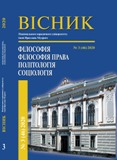СПОСОБИ РЕПРЕЗЕНТАЦІЇ ПОЛІТИЧНИХ АКТОРІВ В УКРАЇНСЬКОМУ ЦИФРОВОМУ ПОЛІТИЧНОМУ ДИСКУРСІ
POLITICAL ACTORS IN UKRAINIAN DIGITAL DISCOURSE: WAYS OF REPRESENTING
Author(s): Nataliia Oleksandrivna SteblynaSubject(s): Politics / Political Sciences, Political Sciences, Civil Society, ICT Information and Communications Technologies
Published by: Національний юридичний університет імені Ярослава Мудрого
Keywords: digital political discourse; political actors; presidential elections; Ukraine; «jeansa»;
Summary/Abstract: Problem setting. In Ukrainian media sphere, the attention towards a political actor may be constructed specially, with the help of the so called «jeansa» (covered political advertisement) dissemination. To understand processes within a political discourse of the country, the mechanism of the texts identification should be designed.Recent research and publications analysis. Several professional NGOs has been monitoring Ukrainian mass media to detect «jeansa» (IDPO (2019), IMI (2019). However, in the times of journalism crisis the problem of media independence and transparency remains a crucial one. Thus, commercial model of journalism should be changed and the reality of «hybrid media system» (Chadwick) should be taken into account.Paper objective is to test a formal method of the «jeansa» materials detection and to define the ways ofpolitical actors representing. Period of research is January-February 2019 (the beginning og the presidential pre-election campaign). Materials of the popular newspaper Segodnya and independent media «Ukrajins’ka Pravda» were compared. For the defining of the non-transparence placement materials a computer program (Python language) was designed.Paper main body. According to the data received, the two ways of political actors representing in Ukrainian digital discourse are defined: with specially created, made attention towards an actor («jeansa») and with an ordinary one. Cases of Ukrainian politicians (presidential candidates, officials) are taken into account.Conclusions of the research. For the first way constant, regular mentions ofa political actor (one-two per day) are typical. In that case the existence of non-transparence placement materials of a news site may be stated. However, for the complete picture it is recommended to consider other data: number of mentions and polls results comparison, coverage of a political actor activity in different mass media analysis. For the second way several options were found. The first one - without breaking news occasions (court hearings, resonant statements, scandals, insults etc); in that case small number of mentions per day (one-two) is also discovered, however, there are significant silent periods, when there are no mentions at all. However, there is a concentrated placement of the mentions, near the certain news occasion. The second one with single irregular mentions there are splashes of attention and more concentrated placement of mentions (near the occasion as well). However, the analysis has some limitations, for instance, it is problematic to define the specially created attention towards the high-ranked officials (presidents).
Journal: Вісник НЮУ імені Ярослава Мудрого. Серія: Філософія, філософія права, політологія, соціологія
- Issue Year: 46/2020
- Issue No: 3
- Page Range: 192-205
- Page Count: 14
- Language: Ukrainian

